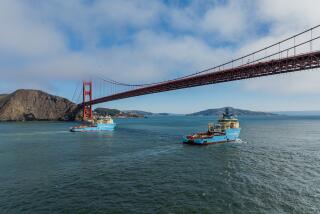Less-Visible Oil-Skimmer Ships Toiled Around Clock
- Share via
HUNTINGTON BEACH — Miles from the surf, sand and curious public, more than 100 people on an oil-cleanup crew have been laboring virtually unnoticed for days aboard vessels bobbing off the Orange County coast.
While beachfront cleanup crews draw the most public attention, clad in bright yellow slickers as they shovel oily muck from the shore, these offshore crews perform a similarly painstaking job in an attempt to clean the ocean’s surface.
The repetitive work, called skimming, begins by corraling oil-tainted water with floating barriers called booms, then using conveyor belts or pumps to sweep the oil off the water’s surface, 150 feet at a time.
“Tedious is a good word for it,” said Coast Guard Chief Warrant Officer Dan Dewell. “That’s the thing about an oil spill. People get their adrenaline up because it’s an emergency, but once the (cleanup) equipment is in place, it’s actually a very industrial, labor-intensive, step-by-step process.”
Skimming equipment that attaches to a boat can cost from $5,000 to $200,000, while the skimming vessels themselves, with built-in equipment, can run into the millions. Booms can cost from $15 to $200 per foot, depending on their degree of sophistication, Ploen said.
On Friday, as the seawater-cleanup operation wound down, an oil company spokesman said the results showed a higher-than-usual success rate in mopping up the slick that has floated offshore since the tanker American Trader spilled 394,000 gallons of Alaskan crude oil last week off Huntington Beach.
“They’ve picked up over 25% of the entire spill, which is far beyond what anyone expected,” said Tony Kozlowski, spokesman for British Petroleum. “The average collected from most spills is only about 7% or 8%.”
A Coast Guard spokesman said the skimming operation, as of late this week, totaled 3,562 barrels of oil, which equals 149,604 gallons.
According to Skip Onstad, manager of Clean Seas, an oil-cleanup firm that sent two skimming vessels down from Santa Barbara, the success rate was aided by calm seas and low winds during the first five days of the spill.
But later on, high winds and near-freezing temperatures from an Artic cold front interrupted the skimming process, sending most of the floating slick onto the beaches. Three boats remained on duty this weekend to pick up small ribbons of the remaining oil slick. At its peak, the skimming operation included 22 boats and more than 100 workers rotating shifts around the clock, which meant many sleepless nights for overseers of the operation, BP’s Kozlowski said.
“We’ve been working for two days with no sleep,” Capt. Bob Cameron said in an interview last Saturday, when the 3-day-old oil slick stretched for 14 miles off the coasts of Huntington Beach and Newport Beach.
Cameron, BP’s marine superintendent for the cleanup operation, said coordination of numerous organizations providing cleanup equipment “has been a good effort on everyone’s part.”
Providers included the Navy, the Coast Guard, wholesale equipment firms, local government agencies and members of the California Oil Spills Cooperatives, a group of private cleanup firms collectively financed by oil companies.
Consultants from various companies were also dispatched to ensure that the equipment was being properly used.
“Sometimes, I have to come out here and point at something to tell the workers what it is,” said Mark Ploen, operations manager for Ajit Shah Inc., a wholesaler of oil-cleanup equipment.
On a tour of the skimming operation last weekend under hazy skies and warm, afternoon sunshine, bright orange booms surrounded the disabled American Trader--since moved to Long Beach harbor--and the smell of oil-exhaust permeated the air.
“The oil follows the current, and depending on how fast it’s going, that is how much boom you have to have,” Ploen said. “And the booms will only hold oil if the current is traveling 1 knot or less. If you try to anchor the boat, sometimes the oil gets away.”
An estimated 43,000 feet of booms had been used by late this week in the skimming operations. The booms also were used to prevent oil from intruding on sensitive shoreline areas, Kozlowski said.
The inflatable booms used in the Huntington Beach spill are made of fiberglass frames surrounding a spring mechanism that expands when air enters through a series of one-way valves, Ploen explained. The booms also have a flap-like piece underneath, hanging 20 to 40 inches below the water’s surface, which works to hold the floating oil in place.
The skimmers’ huge, V-shaped collector arms can span up to 200 feet of oil-tainted water. The arms scoop up oil being contained by the booms and move it onto a conveyor belt, where it is then scraped off and dumped into holding tanks. Sometimes, a vacuum-powered pump is used instead of a conveyor belt to suck oil off the water, Dewell said.
More to Read
Sign up for Essential California
The most important California stories and recommendations in your inbox every morning.
You may occasionally receive promotional content from the Los Angeles Times.













